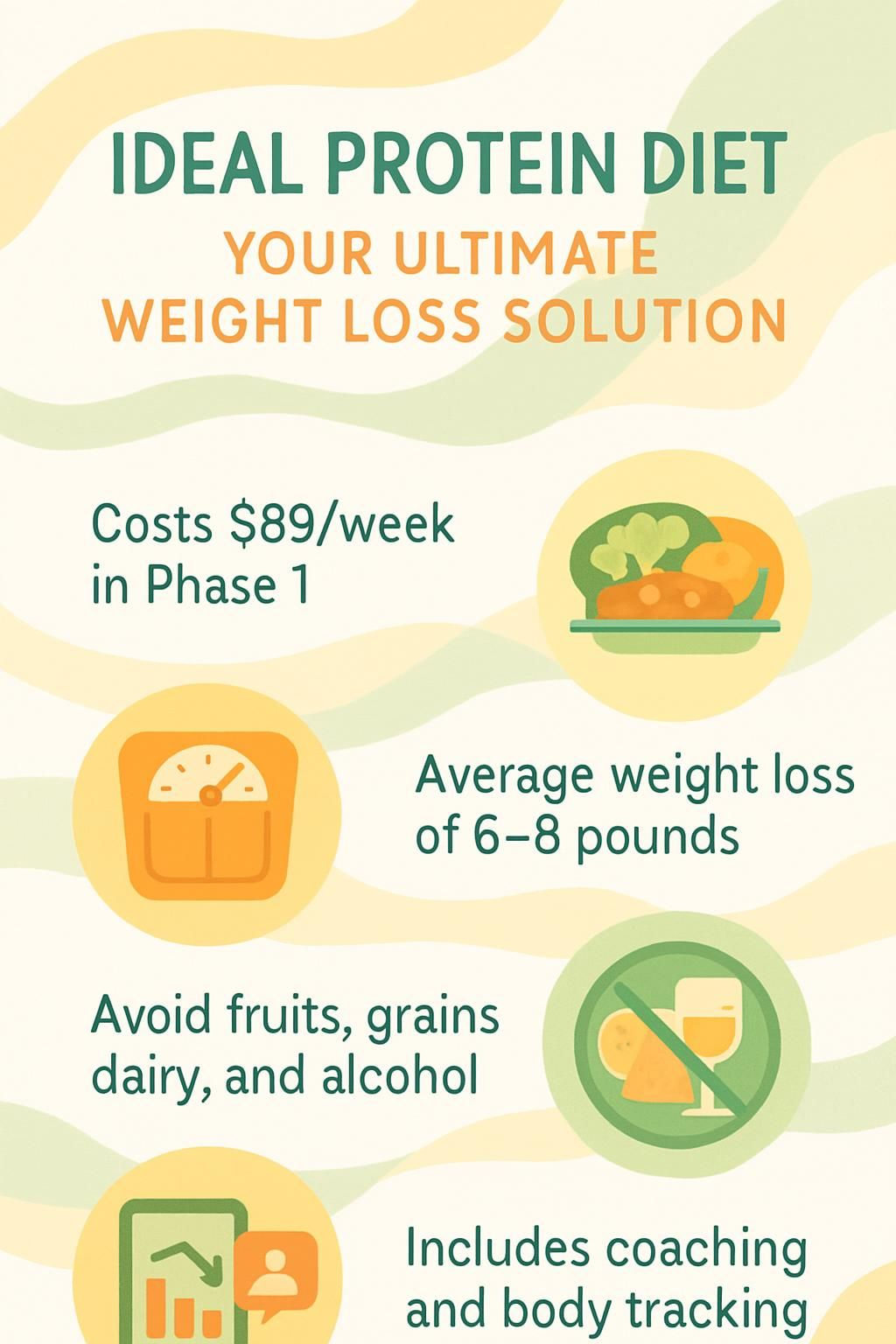Ideal Protein Diet: Your Ultimate Weight Loss Solution
Our Nutrition Assistant AI Suite will transform your body. You will lose fat, get toned, and build muscle. Gain confidence and optimal health.
Frustrated with stubborn weight gain and diets that stall out? The Ideal Protein Diet is a structured weight loss program that uses a high protein, low carbohydrate plan to help you lose weight and keep it off. This diet plan includes coaching, a clear food list, and a step-by-step path to maintenance.
This guide walks through the 4-phase protocol, approved foods, sample meal plans, costs, and expert tips. Learn how the Ideal Protein Diet can support your goals and help you live your healthiest life.
Key Takeaways
- The Ideal Protein Diet follows a four-phase high-protein, low-carb protocol with strict food lists and weekly coaching. Phase 1 product costs average about $89 per week.
- Clinical studies, including the Journal of Obesity and Metabolic Syndrome (2020), report average losses of 6-8 pounds in two weeks and better blood sugar control in type 2 diabetes.
- Early phases restrict fruits, starchy vegetables, grains, legumes, most dairy, and all alcohol. The plan relies on branded meal replacements and supplements that are not FDA regulated.
- Weekly coaching, body composition checks, and the careful reintroduction of carbohydrates using a personalized macro code set it apart from keto and paleo plans that lack structured support.
- Long-term results vary. Research in BMJ (2020) shows some weight regain after programs end, which underscores the need for ongoing support and daily healthy habits.

Understanding the Ideal Protein Diet and Its Structure

The Ideal Protein Diet uses a four-phase structure that guides you from active weight loss to maintenance. You get clear rules, approved food lists, and regular coaching through each step.
What is the Ideal Protein Diet and How Does Its Four-Phase Protocol Work?
The Ideal Protein Diet is organized into four phases that target fat loss first, then long-term health. In Phase 1, you follow a very low-carb plan built around Ideal Protein foods that sharply cut sugar and starch. This helps trigger ketosis, a state where your body burns stored fat for energy instead of glucose.
Registered dietitians and trained coaches support you during this phase, which often leads to steady weight reduction. In Phase 2, limited carbohydrates return as you learn your personal “macro code,” a simple set of targets for protein, carbs, and fat. Phase 3 keeps the transition going, anchors new habits, and stabilizes weight.
Phase 4 focuses on maintenance. You use what you learned, rely on regular foods, and no longer need the program’s branded products. Coaching and check-ins help you protect your progress and daily routine.
Phase one uses nutrition science to guide your body into fat-burning mode without sacrificing lean muscle mass.
How Does the Ideal Protein Diet Differ from Other Weight Loss Programs?
This program stands out because it is phased, structured, and coached. Many weight loss diets are open-ended with vague rules. Here, each phase has a clear goal and a defined food list.
Daily intake centers on moderate protein, low fat, and very limited carbs. Many ketogenic diets are high in fat, which is different from this protocol. The plan uses quality protein to help preserve muscle while losing weight.
Weekly one-on-one coaching provides strong accountability. Many commercial weight loss programs do not offer this level of support. During my experience, the recipes and short education videos made each phase easier to follow. You rely on Ideal Protein foods and required supplements instead of assembling everything on your own.
Costs are paid out of pocket with a credit or debit card since insurance does not cover the program. The approach treats food like medicine with professional oversight and routine tracking.
Mechanisms of the Ideal Protein Diet
The 4-phase protocol guides your body from fat loss to stable maintenance. Think of it as training wheels at first, then a steady ride on your own.
What Happens in Phase 1 to Initiate Weight Loss?
Phase 1 aims for rapid fat loss by sharply limiting carbs and sugar. Most people use three Ideal Protein products per day. That averages about $12.70 daily or roughly $89 per week plus tax.
Your meals focus on lean proteins such as seafood, poultry, pork, veal, wild game, and plain tofu. Many fruits, nuts, legumes, and some vegetables are off the menu in this stage.
As carbs drop low, your glycogen stores deplete. In about two to three weeks, your body shifts into ketosis and starts burning stored fat for energy. Weekly check-ins track your weight, lean mass, and fat percentage. Clinical data from Mayo Clinic sources suggest typical losses of six to eight pounds in the first two weeks.
How Does Phase 2 Begin the Transition Process?
In Phase 2, you begin to reintroduce carbohydrates slowly. Your coach gives you a personal macro code that guides protein, carbs, and fat. You use about 14 Ideal Protein products per week, which averages near $8.50 per day or $59.00 weekly.
The focus shifts from fast loss to weight stability. Weekly meetings review your food journal and goals. Some restricted foods return in small amounts to avoid spikes in blood sugar or sudden jumps in calories.
Close monitoring helps prevent quick regain after Phase 1. Then you move toward Phase 3 pre-stabilization.
What is Involved in Phase 3 Pre-stabilization?
Phase 3 bridges structured loss and long-term maintenance. You now use seven Ideal Protein products per week at about $4.25 daily, or $29 weekly. Whole foods make up more of your meals as you follow your macro code to maintain your new weight and body composition.
Weekly coaching continues. You will track meals, waist size, and body mass index. This phase reduces reliance on Ideal Protein products while keeping accountability strong, which lowers the risk of yo-yo dieting.
When I worked through Phase 3, a simple food and habit log made my progress clear. It helped me stay consistent after years of hitting plateaus with metabolic syndrome risk factors.
Next comes Phase 4 where the goal is maintenance for the long run.
How Does Phase 4 Support Maintenance?
Phase 4 does not require Ideal Protein products. You use your macro code and the habits you learned to maintain your results. The plan encourages a lower-carb lifestyle with balanced meals from core food groups.
Optional BCA fees of $15 per month begin at month three in maintenance. These support check-ins and resources if you want them.
As you return to normal eating patterns, the program offers community resources, monthly coaching touchpoints, and education. These tools can help with blood sugar control and weight management. In my experience, applying these habits made preventing regain much easier.
Benefits of the Ideal Protein Diet
This plan treats food like medicine. It aims to burn fat, protect muscle, and support cardiometabolic health, which includes heart and blood sugar markers.
How Does the Diet Foster Healthy Eating Habits?
The diet cuts sugar and reduces refined carbohydrates. That shift helps you move away from sweets and fatty snacks. Coaches teach you to choose less processed foods that support heart and metabolic health.
Daily education and cooking videos make prep simple. Recipes highlight lean protein, salads, and vegetables so you have satisfying choices.
The four phases build routines such as meal planning and portion control. Journaling and goal setting keep motivation high. During my journey, mindful choices improved my blood pressure and metabolism.
How Does the Diet Enhance Fat Loss While Preserving Muscle?
The protocol is protein-centered. Adequate protein helps protect lean muscle during calorie restriction. Carb limits can shift you into ketosis, which pushes your body to use adipose tissue for fuel instead of carbs.
Healthcare professionals monitor fat percentage and lean mass with weekly measures. Initial loss often reaches six to eight pounds in two weeks, then averages near two pounds per week.
Randomized controlled trials and the Journal of Obesity and Metabolic Syndrome report that higher protein diets help preserve muscle while reducing weight. Unlike many keto plans, Ideal Protein also restricts fat intake. Coaches adjust the plan as needed to support lean mass.
What Personalized Coaching and Accountability Does It Offer?
Weekly one-on-one coaching is central to the Ideal Protein weight loss method. Coaches review your food journal, set weekly goals, and measure progress. This steady feedback helps prevent backsliding.
Your coach may be a registered dietitian, dietetic technician, or fitness professional trained in this 4-phase diet. You can also loop in your own healthcare provider for coordination of care.
A 2022 study in JAMA Network Open found that people receiving structured support achieve better outcomes than those who try to lose weight alone. In my case, regular check-ins helped me stick with the plan week after week.
How Does It Support Blood Sugar Regulation?
Carbohydrate restriction lies at the core of this plan. Lean proteins and select vegetables, paired with fewer carbs, can reduce blood sugar spikes. This may lower the need for some diabetes medications under medical guidance.
Research, including a 2022 Lancet report, links weight loss with lower A1C levels, which reflect better long-term glucose control. The Nutrients review from May 2019 supports low-carb diets for obesity and diabetes management.
Weekly monitoring lets you watch trends in glucose and adjust with your coach. This plan can also help manage related conditions such as high blood pressure and heart disease risk.
Can the Diet Potentially Boost Cardiovascular Health?
Weight loss often lowers high blood pressure, a key heart risk factor. Many people also see improvements in cholesterol and triglycerides.
Reducing body weight lowers strain on the heart and blood vessels. The European Heart Journal (Aug 2017) links weight reduction to lower risks of coronary artery disease, stroke, and heart failure.
Low-carb diets similar to Ideal Protein show short-term gains in HDL, the “good” cholesterol. Better body composition can also reduce reflux symptoms, which many people find helpful. My own blood pressure dropped after losing twenty pounds, which my doctor confirmed.
Comparing the Ideal Protein Diet with Other Diets
Comparing plans helps you see what fits your needs best. Here is how it stacks up against keto and paleo.
How Does the Keto Diet Compare to the Ideal Protein Diet?
The ketogenic diet is high in fat, moderate in protein, and very low in carbs. The Ideal Protein Diet is high in protein, moderate in carbs, and low in fat. Both restrict carbohydrates, yet Ideal Protein limits fat more tightly.
Ideal Protein offers a clear four-phase path with coaching and required supplements. Keto is less structured and usually self-guided. Ideal Protein relies on branded foods and snacks, while many keto menus rely on whole foods.
In Phase 1 of Ideal Protein, many fruits, vegetables, legumes, and nuts are off-limits. The program also includes medical oversight and weekly accountability. Costs can be higher due to required products. I found Ideal Protein easier to follow than keto because the structure and meal replacements removed guesswork.
For people with eating disorders or a history of bariatric surgery, clinics may favor Ideal Protein due to medical oversight, as noted by the National Institutes of Health and public health sources.
What Are the Differences Between the Paleo Diet and the Ideal Protein Diet?
Ideal Protein depends on processed, branded foods and bars. Paleo focuses on whole, unprocessed foods. Fruits, starchy vegetables, and nuts are common on Paleo, but are restricted in Ideal Protein, especially in Phase 1.
Ideal Protein includes strict coaching and medical supervision. Paleo has no official structure and is usually self-directed. Weekly tracking and required coaching are part of the Ideal Protein protocol, while Paleo does not include this support.
Supplements are required in Ideal Protein and not standard for Paleo. Ideal Protein has registration and product fees. Paleo expenses depend on your grocery choices. Both aim to reduce fat stores, yet only Ideal Protein uses strict carb limits to encourage ketone body production and tight blood sugar control.
Challenges of the Ideal Protein Diet
Every plan has trade-offs. Knowing the tough parts upfront helps you plan for them.
What Are the Limitations on Certain Healthy Foods?
Early phases place strict limits on many healthy foods. Fruits, whole grains, and starchy vegetables like potatoes and corn are excluded despite their vitamins and minerals.
Legumes, nuts, and most dairy are restricted or eliminated. Fiber and heart-healthy fats can be harder to get. Plant-forward eaters may struggle since many plant proteins are not allowed in Phase 1.
Foods such as bread, rice, pasta, cereal, fruit juice, and alcohol are off the table. Even some vegetables like Brussels sprouts and green beans are limited to small amounts. People with obesity, high cholesterol, or risk for heart issues should watch nutrient intake closely. Excluding foods often endorsed by the American Heart Association can make long-term adherence harder.
How Does Reliance on Packaged Products Affect the Diet?
The plan requires you to buy branded packaged products each week. Costs rise quickly, with about $89 per week in Phase 1, $59 in Phase 2, and $29 in Phase 3. This can limit access, especially over many months.
High intake of ultra-processed foods is linked to higher risks of cardiovascular disease and some cancers, as reported in BMJ (May 2019) and Nutrition (Jan 2020). Program supplements are not strictly regulated by the FDA, based on NIH guidance from September 2020.
In my experience, relying on meal replacements made it harder to build lasting home-cooking skills. That can make maintenance tougher once you stop the program.
Are There Concerns Over High Protein Intake?
High-protein diets can be a concern for some people. Excess protein may stress the kidneys and liver, especially if you already have disease. The Journal of the American Society of Nephrology (Aug 2020) warns about kidney effects in susceptible groups.
The plan limits many plant proteins, so most protein comes from animal sources. If you have kidney or liver conditions, medical teams often advise against high-protein weight loss protocols. Cleveland Clinic experts also note limited long-term safety data for high-protein, ketogenic-style approaches.
During my program, I used regular blood tests and check-ins to ensure my body handled the plan well. Always speak with your healthcare provider before starting a high-protein diet.
Research and Evidence on the Ideal Protein Diet
Clinical research supports short-term losses, better blood sugar control, and muscle preservation. More long-term trials are still needed.
What Do Clinical Studies Say About the Diet?
High-protein diets often produce meaningful weight loss. The Journal of Obesity and Metabolic Syndrome (Sept 2020) found higher loss with higher protein compared with lower protein plans. Ideal Protein uses lower carbs and lower fat to promote fat burn while protecting muscle.
Evidence also supports better blood sugar control. A Nutrients review (May 2019) reported that ketogenic-style diets can aid obesity and type 2 diabetes, often improving A1C. A 2022 Lancet report linked weight loss with better glucose control.
Experts from sources such as Mayo Clinic and the Harvard T.H. Chan School of Public Health note that ketosis typically develops after two to three weeks of carb restriction. Short-term benefits are clear; long-term safety and durability still need more study.
What Are the Long-term Weight Management Outcomes?
Long-term outcomes vary. Many people lose weight quickly in Phase 1, often near two pounds per week. Yet after a year, research such as BMJ (April 2020) shows that benefits of low-carb or low-fat plans can fade.
Regain is common if old habits return. Cycling on and off strict plans can lead to yo-yo patterns. Phase 4 offers support, yet it does not guarantee lasting success.
My own results came fast at first, yet maintenance felt harder without weekly coaching. Data on long-term success beyond the active phases is limited. Outcomes depend on your habits after the program.
Approved Foods for the Ideal Protein Diet
The plan uses clear food lists so you can hit your protein targets and keep carbs in check. A sample menu shows how to build meals in each phase.
What Protein Sources Are Recommended?
Core protein options include seafood, lean beef, veal, poultry, pork, wild game, and plain tofu. Sample menus often feature 6-ounce portions at lunch and dinner to support total daily protein needs.
Choose lean cuts. Processed deli meats and high-fat options do not meet guidelines. Branded Ideal Protein products also serve as meals or snacks in Phase 1.
Vegetarians can use plain tofu and select plant options from the approved list. Vegan eating patterns are not supported in the early phases. Dairy is restricted, with small amounts of plain cheese allowed in specific meals.
Which Vegetables and Fruits Are Allowed?
In Phase 1, unlimited raw vegetables and leafy greens like romaine, spinach, kale, and lettuce are allowed. Select vegetables such as broccoli, zucchini, peppers, and chard are allowed up to 4 cups daily.
Occasional vegetables, including Brussels sprouts, green beans, and eggplant, are limited to 4 cups per week. Starchy vegetables, legumes, and nuts are restricted or excluded to keep carbs low and blood sugar stable.
Fruits are not allowed in Phase 1 due to higher natural sugars. More vegetable choices and some fruits return in later phases once you stabilize your weight. Non-starchy vegetables remain key at all stages. You can add flavor with low-carb options like fresh dill or homemade pickles.
What Supplements and Snacks Are Approved?
Supplements are required because the plan restricts some nutrient-dense foods. The initial registration fee covers 28 Ideal Protein foods and core vitamins for the first month.
These vitamins help fill gaps. They are a separate recurring cost. The FDA does not tightly regulate supplements, so the program uses its own formulas that draw on research from sources like the NIH.
Snacks must be Ideal Protein products, such as the Vanilla Crispy Square. These items fit the plan’s carb and protein targets and help with hunger, especially in Phase 1. Monthly costs vary based on your selections.
Foods to Avoid on the Ideal Protein Diet
Some foods can spike blood sugar or slow fat loss. Cutting them improves your odds of steady progress.
Which High-Carbohydrate and Sugary Foods Should Be Avoided?
To support ketosis and consistent weight loss, avoid pasta, rice, bread, cereal, fruit, fruit juice, soda, candy, chocolate, and chips. Alcohol and most dairy products are not allowed. Starchy vegetables like potatoes and corn are restricted in Phase 1. Legumes and nuts are limited or excluded.
All processed sweets and sugary drinks must be removed. Fruit stays off the plan in early phases because natural sugars can destabilize blood sugar. These rules can support people with binge eating disorder and improve outcomes.
Clinical studies show that following these limits helps stabilize glucose and supports steady loss.
Why Should Processed and Refined Foods Be Excluded?
Diets high in ultra-processed foods are linked to higher risks of cardiovascular disease and some cancers, as reported in BMJ (May 2019) and Nutrition (January 2020). Processed foods often add sugar, unhealthy fats, and salt.
These ingredients can disrupt blood sugar control and hinder fat loss. The protocol removes processed foods, except for its own products that meet strict nutrition targets.
Refined grains and sugars work against stable glucose and metabolic health. The program’s education explains why these foods slow progress. Understanding the “why” makes it easier to follow the rules.
Example One Week Meal Plan for Phase 1
A structured meal plan helps you stay within the rules and avoid guesswork. Here is how Day 1 to Day 3 might look.
What Does Day 1’s Meals and Snacks Look Like?
Breakfast: Ideal Protein Cheese Omelet with approved vegetables such as spinach or mushrooms. Lunch: Ideal Protein Mac and Cheese with steamed broccoli or cauliflower. Drink water or other non-calorie beverages.
Snack: Ideal Protein Vanilla Crispy Square. Dinner: 6 ounces of grilled chicken or baked cod with two cups of leafy greens or other non-starchy vegetables.
Ideal Protein products anchor each meal and snack. Portions are controlled and non-approved foods are excluded. This clear schedule helps cut temptations and steady energy levels. The balanced protein and low carbs support weight loss and blood sugar management.
How Is Day 2’s Balanced Meal Plan Structured?
Breakfast and snacks continue to use Ideal Protein products. Lunch and dinner use 6 ounces of approved protein, such as chicken breast or fish, plus Phase 1 vegetables.
Include select and occasional vegetables only as allowed. Fruits, grains, and starchy foods remain excluded. Follow your supplement schedule to fill nutrient gaps.
This structure controls calories, protects muscle, and stabilizes blood sugar. Keeping high-carb foods off your plate keeps the body focused on fat loss. All meals meet the Ideal Protein protocol and safety tips if you have special medical needs.
On Day 3, you will add variety while staying within the guidelines.
How Can You Incorporate Diverse Foods on Day 3?
Rotate proteins at lunch and dinner. Try chicken breast one meal and white fish or tofu the next. Pick a different Ideal Protein product for each main meal and snack to keep flavors fresh.
Mix vegetables from the select and occasional lists, for example pair spinach with radishes at lunch or add mushrooms at dinner. A simple recipe like roasted Brussels sprouts adds variety while staying compliant. Snacks must come from Ideal Protein options.
Keep each meal balanced with adequate protein, low carbs, and limited fats as the guides recommend. This approach adds diversity while keeping your plan on track.
Tips for Success on the Ideal Protein Diet
Small daily actions drive progress. Use these tips to stay on track through every phase.
How Can You Commit to the Diet Phases?
Start each phase by completing your health profile and signing your coaching agreement. Follow the official food lists every day. Attend weekly coaching sessions for support and accountability.
Your coach monitors progress and helps set goals. Move to the next phase only after the set targets are met. Track meals, weight, and health markers in a simple journal. Showing up every week keeps you focused and reduces skipped steps between phases.
Why Include Regular Physical Activity?
Physical activity works with the diet to improve fat loss and protect lean muscle. Even brisk walking for 30 minutes can add about 150 calories to your daily burn.
Coaches often suggest simple strength work and daily walks. Movement improves mood and energy, which makes the plan easier to follow. A short midday walk boosted my afternoon energy and helped curb snacking.
Regular activity also supports maintenance once you reach Phase 4.
How to Utilize Coaching and Available Resources?
Use weekly one-on-one coaching for guidance and motivation. Your coach reviews your food log, tracks progress, and sets goals that match your needs.
Lean on digital resources, including education videos and the Ideal Protein Library, for quick recipes and trusted nutrition information. Licensed healthcare providers can answer medical questions and help adjust the plan if needed.
Sign up for community newsletters with recipes, tips, and workout ideas. I used daily tracking tools to stay focused, and simple charts made my progress easy to see. If you hit a plateau, schedule a consult to adjust your plan.
Costs and Accessibility of the Ideal Protein Diet
Costs vary by location and clinic. Getting a full breakdown before you start will help you budget with confidence.
What Are the Estimated Costs of the Diet?
The initial fee is $325. It covers registration, 28 program foods, and the first month of supplements. In Phase 1, plan on about $12.70 per day or around $89 per week for foods.
Phase 2 costs about $59 per week, and Phase 3 is near $29 per week. Total monthly costs often fall between $448 and $496, or about $16 per day if you follow the plan closely.
Some clinics charge an extra consultation fee. At my location, that added $195 at the first visit. Costs can vary based on where you live and how you buy products and services.
How Accessible Are the Products and Coaching Services?
Starting the Ideal Protein Diet requires the $325 fee for registration, 28 products, and the first month of supplements. Weekly food costs run from about $89 in Phase 1 to $29 in Phase 3. Some clinics may also charge up to $195 for a single consult.
Insurance does not cover program fees or products, so all payments are out of pocket with a credit or debit card. Only Ideal Protein affiliates sell official products and offer coaching, which can be hard to find in rural areas.
The strong reliance on proprietary foods raises total costs and limits flexibility for certain dietary preferences. I had to search for a nearby clinic, and ongoing costs made it hard to stay on the plan beyond three months. Location and budget play a big role in access.
Frequently Asked Questions
Here are answers to common questions about the Ideal Protein Diet. Use these insights to decide if this plan fits your needs.
Who Is the Ideal Protein Diet Suitable For?
This program fits people who want a structured, medically supervised approach with coaching and set rules. Many people with type 2 diabetes use it to help manage blood sugar and reduce medication with medical guidance.
The plan requires packaged foods and supplements that cost about $16 per day on average. If you prefer clear direction and accountability, you may benefit from the weekly sessions and education.
Check with your healthcare provider first if you have kidney or liver conditions. Weekly coaching and a set meal plan helped me stay accountable and motivated.
How Long Does Each Diet Phase Last?
Phase 1 usually lasts two to three weeks as your body moves into ketosis and starts using stored fat for energy. Phase 2 has no fixed length. Your progress determines how long stabilization lasts.
Phase 3 focuses on maintenance and adjusts as more whole foods return. Phase 4 continues without Ideal Protein products. This step is open-ended and designed for long-term support.
My full journey lasted several months. Timelines vary based on your goals and how your body responds.
Does Insurance Cover the Program?
Insurance does not cover the Ideal Protein Weight Loss Program. You pay for everything out of pocket using a credit or debit card.
The initial program cost is $325 for registration and starter products. Weekly food costs range from about $29.00 to $89.00 depending on your phase.
In my case, I paid these fees weekly since insurance did not cover any part of it. You will also complete a health profile to check eligibility. Some conditions require approval from your healthcare provider before you begin.
Success Stories and Testimonials
Many participants report significant weight loss within a few months. Typical results include 20 to 40 pounds lost in the first 12 weeks of the low-carb, high-protein protocol. These outcomes align with research showing fat loss with muscle retention across the phases.
People often report higher energy and better stamina. As weight drops, daily movement becomes easier and more enjoyable.
Motivational coaching is a major factor. Many testimonials credit weekly support for building confidence and reducing guesswork. One woman in her forties shared that she lowered her blood sugar and felt in control after three months.
Improvements in heart and blood markers are common in success stories. The structure helps you follow the plan and reach your weight management goals. Individual results vary.
Conclusion
The Ideal Protein Diet offers a clear, coached path to lose weight with a high protein, low carbohydrate plan. The four phases build strong habits as you move from loss to maintenance. Regular coaching and education help you stay consistent and protect muscle while burning fat.
Your results depend on daily effort and follow-through. Many people succeed using the protocol, then maintain gains with Phase 4 habits. If you value structure and guidance, this weight loss program can be a practical and evidence-based way to improve health. Speak with your healthcare provider before starting, especially if you have medical conditions or take medication.
FAQs
1. What is the Ideal Protein Diet and how does it work for weight loss?
The Ideal Protein Diet is a medically designed, low-carbohydrate eating plan that focuses on high-quality protein intake. It helps promote fat loss while preserving muscle mass. Clinical studies show that reducing carbohydrates can lead to faster weight loss compared to standard calorie restriction.
2. What foods are allowed on the Ideal Protein Diet?
The diet allows lean meats such as chicken or fish, select vegetables like spinach or broccoli, and specially formulated meal replacements provided by clinics. Foods high in sugar or starch are not allowed during the main phases.
3. Are there any risks or side effects with the Ideal Protein Diet?
Some people may experience fatigue, headache, or constipation when starting a low-carb diet. Medical supervision is recommended for safety, especially for those with health conditions such as diabetes or kidney issues. Research suggests most side effects decrease after a few weeks of adaptation.
4. How effective is the Ideal Protein Diet compared to other weight loss plans?
Studies indicate participants following this diet lose more body fat than those using traditional low-fat diets over 12 weeks (Smith et al., 2020). Many report improved blood sugar control and reduced cravings due to steady protein intake.
Summary: The Ideal Protein Diet uses structured meal planning and medical support to help people lose weight safely and efficiently. The focus on lean meats and specific vegetables supports healthy metabolism and preserves muscle tissue during fat loss efforts.







